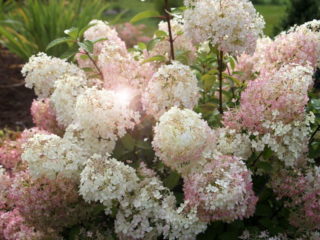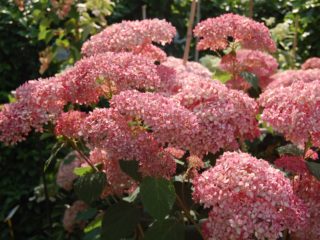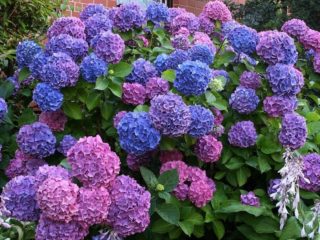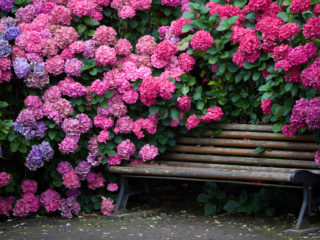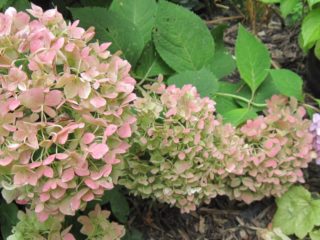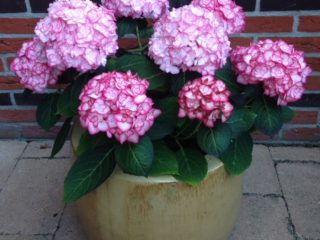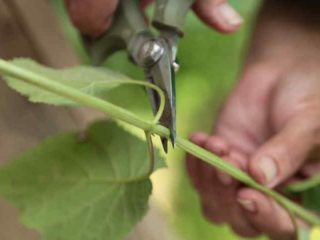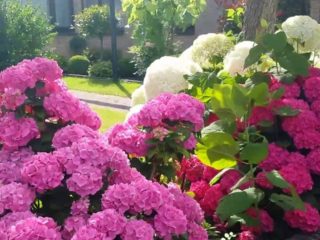Content
Ornamental trees and shrubs of Bretschneider's hydrangea are in great demand among gardeners due to their good resistance to drought and wintering. In addition, they are very impressive and beautiful during the flowering period, which lasts throughout the summer season. You will only have to work hard on caring for the plant the first time in order to create favorable conditions for it. In the future, the Bretschneider hydrangea needs to be well watered and the soil under it loosened.
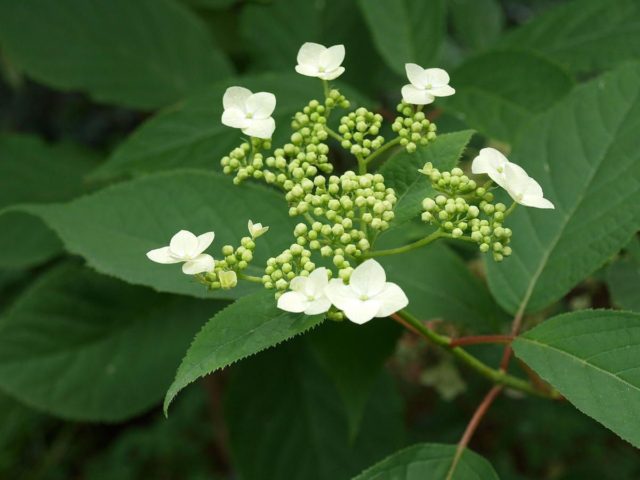
The variety blooms with “umbrellas”, which makes it stand out from other species.
Description of Bretschneider's hydrangea
Bretschneider hydrangea (hydrangea bretschneideri) is a perennial plant up to 3 m tall. The crown is round, the foliage is elongated, pointed, about 12 cm in size. The plant has a strong trunk with dense foliage. The flowers are initially white, arranged in the form of umbrellas about 15 cm. Closer to autumn they acquire a purple color, which is where the second name of the species “Purple Queen” comes from.
It blooms actively throughout the summer season, despite possible drought. The plant is sun-loving, although it requires good watering and slight shade. It is winter-resistant; you just need to do some minor pruning.
Bretschneider's hydrangea in landscape design
Brettschneider's groundcover hydrangea, also known as Purple Queen, is an excellent choice for landscape gardeners. The plant looks great alone. It is also grown in combination with other deciduous shrubs, including evergreens and ornamental ones. The harmony of this variety in combination with coniferous species is noted.
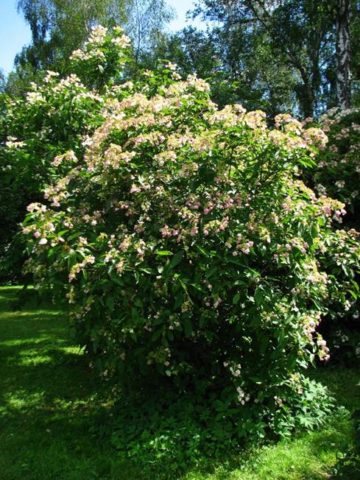
Brettschneider's ground cover hydrangea is grown as a hedge
Winter hardiness of Bretschneider hydrangea
This hydrangea variety is characterized by its resistance to drought and frost. Growing in the middle zone in a temperate climate, the plant is not insulated for the winter.
Planting and caring for Bretschneider hydrangea
Brettschneider's groundcover hydrangea seeds are planted in open ground in mid or late spring, when the frosts have passed and will not return. But the soil is prepared in advance, from the autumn period. Peat and sand are added to the main soil. Before planting, you need to thoroughly clear the ground of weeds, then the seeds are slightly deepened into the soil and sprinkled with a thin layer of sifted sand on top.
Seedlings germinate slowly, and the plant must be constantly loosened, weeded, replanted if necessary, and the soil must be fertilized.
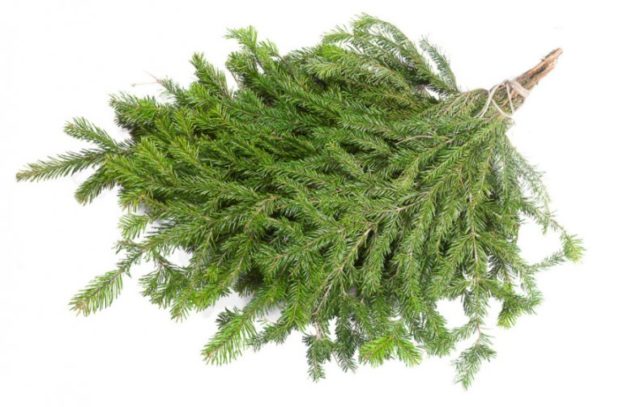
During the first winter seasons, the plant is wrapped in non-woven material and spruce branches (spruce branches)
Selection and preparation of a landing site
Hydrangea of this variety is planted in a sunny area, but strong gusts of wind and drafts should be excluded. Groundcover hydrangea can be placed near a fence or next to a large tree. In addition to the fact that the plants will look harmonious, the hydrangea is protected from the winds. The plant prefers plenty of sunlight, so care should be taken when planting it under trees.
Ground cover hydrangea is usually planted in the spring, when frost is no longer expected. But the soil is prepared in the fall, loosening it, mixing it with acidic peat, compost and other organic fertilizers.
Landing rules
Planting holes for hydrangea are prepared about half a meter deep. If the gardener decides to do without fertilizers, the planting holes are dug deeper. First of all, additional roots will grow above the ground, and secondly, in the depths the soil is richer in minerals than the upper layers. Therefore, it is recommended to use additional peat and fertilizing.
Having placed the hydrangea in the hole, its roots are thoroughly straightened, sprinkled and compacted so that they come into contact with the ground, otherwise a void will form, which can result in drying out.
If branches and roots are damaged during planting, they are carefully trimmed. After the planting procedure is completed, the plant is watered abundantly so that the ground is saturated with moisture for at least half a meter. In summer, mulching is done so that the soil does not overheat and beneficial minerals do not evaporate.
Watering and fertilizing
Hydrangea is actively watered, especially during the season when there is not enough rainfall.Despite the fact that the Bretschneider variety tolerates the sun well, at the same time, like other varieties, it needs good, stable watering.
Gardeners fertilize the soil at their discretion. You can use humus, additional acidified peat, and also mix in some mineral fertilizers. Among other things, hydrangeas are given a separate type of fertilizer, rich in iron and magnesium.
The first feeding is carried out in May or June, repeated procedures are done every two weeks until the trunk becomes woody.
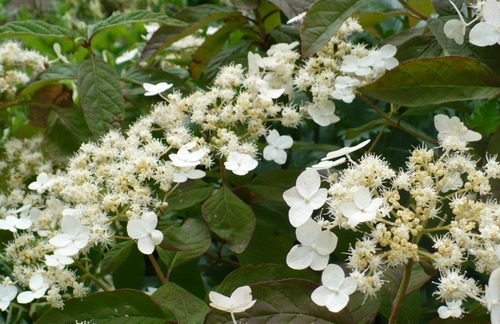
By the end of summer, complementary feeding is eliminated
Trimming
Pruning is carried out in early spring, before the so-called sap flow begins, i.e. shortly before the plant awakens from wintering. If the gardener missed this point, then pruning is postponed until the period when the petals begin to bloom.
Pruning allows you to give the bush its shape and also control the number of flower umbels. If necessary, young shoots are pruned; they can be used for cuttings of hydrangea.
By the wintering period, faded buds, weak and dried branches are cut off. Sometimes gardeners can cut off most of the plant so that it is completely renewed in the spring.
Preparing for winter
Bretschneider's hydrangea tolerates winter stoically, so many gardeners prefer not to bother preparing the plant for frost. The best option for caring for shrubs is to insulate the soil, that is, mulch. In the case of this type of plant, preference is given to organic mulch, for example, autumn fallen leaves, sawdust, bark. The point is that they will not only create greenhouse conditions for the roots, but also by spring they will improve the soil and increase its beneficial properties.
As for the crown of the ground cover hydrangea, it would not be superfluous to wrap it in kraft paper or other covering material during the cold season. When warm days arrive, around April, all these auxiliary materials are removed. This is done in the evening so that the first warm rays of the sun do not harm the awakening plant.
Reproduction
The plant is propagated by all known methods. The best option is cuttings. Cuttings are rooted during the flowering period of hydrangea, which are cut from annual shoots. The cuttings are placed in water, but to speed up the process, you can use a light, moisture-intensive substrate of peat and sand in a ratio of 2 to 1. You can also mix in sphagnum moss.
After the roots have erupted, the cuttings are planted in the substrate at a distance of about 5 cm from each other. At a temperature of about 20 ° C, hydrangea takes root within a month.
You can use the method of dividing a bush, when in spring or autumn you dig up a bush, divide it into 2-3 parts and plant it.
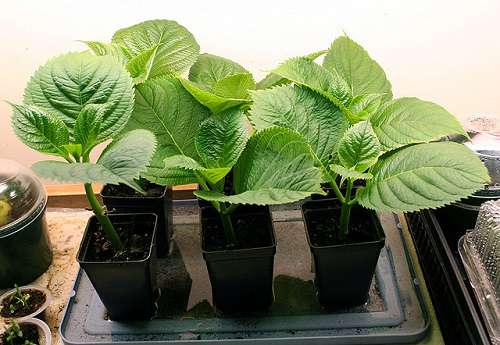
Cuttings are the most common method of propagation
Propagation by seeds is the longest and most troublesome. The seeds are quite small, so they are initially placed in boxes with slightly acidic soil. It is made from leaf soil, humus, peat and coarse sand, taken in proportions 2:2:1:1, respectively.
The seeds are not buried, but rather scattered on the soil, sprinkled with sand on top. Next, they are sprayed with a spray bottle; the first shoots promise to appear in a month. By autumn they reach a height of about 40 cm. The first wintering should be provided with good greenhouse conditions.
Diseases and pests
In addition to the above-described benefits of hydrangea, it is also resistant to diseases.Of course, you cannot do without aphids and spider mites, but they are quite easy to remove. In particularly wet seasons, hydrangea can contract the fungal disease “powdery mildew”. It is not good when the soil from which the plant grows contains lime; under its influence, the hydrangea becomes lighter.
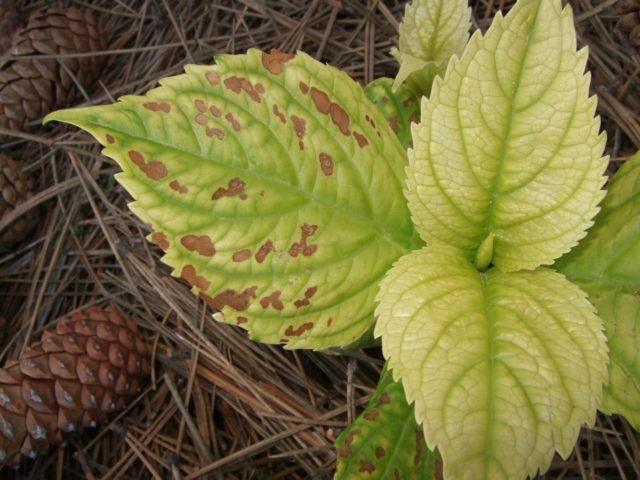
An excess of humus in the soil is also dangerous for the development of hydrangea chlorosis
Conclusion
Ornamental trees and shrubs of Brettschneider hydrangea are an excellent choice for both beginners in floriculture and master gardeners. In addition to the fact that the plant gradually changes its colors, it does not require unnecessary care procedures, except perhaps in the first few seasons.
Reviews of Bretschneider's hydrangea
Ornamental trees and shrubs of Brettschneider hydrangea are famous all over the world.
